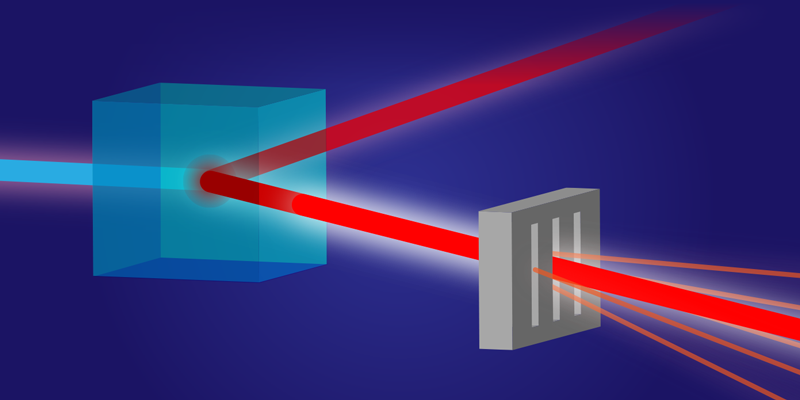X-Ray Imaging Goes Quantum
Quantum imaging exploits quantum weirdness to improve the resolution or other properties of an imaging system. The approach has been widely applied to imaging with visible light, but a team has now demonstrated this quantum enhancement at x-ray wavelengths. The researchers developed the first x-ray source that can generate a so-called quantum correlation between two photons—a long-distance, quantum mechanical relationship. The team used the photon pairs to image a simple object. The results show that quantum correlations improved the sharpness of the acquired image and suggest that similar approaches might benefit other x-ray-based research, such as studying defects in materials or determining the structures of biomolecules.
Researchers have demonstrated several ways to harness the quantumness of light for better measurements. An important approach, known as quantum illumination [1], allows the imaging of an object with very few photons or in the presence of background light, smoke, or dust. The scheme usually involves two photons having a strong type of quantum correlation called entanglement, but weaker correlations can work as well. The first photon is an “ancillary” photon, which serves as a reference, and the second is a “signal” photon, which is sent toward the object to be imaged. A correlation-sensitive detection scheme can pick out the signal photon even when it comes within a large stream of background photons from the environment.
“Extending these ideas to x rays would have key advantages,” says Sharon Shwartz of Bar-Ilan University in Israel. For instance, x rays can image with atomic resolution and can probe the structure of atomic nuclei, features inaccessible to experiments with visible light, he says. However, no one has yet developed a source of quantum correlated x-ray photons.
To develop such a source, Shwartz and his team exploited a process known as parametric down-conversion, which is routinely used to generate entangled visible photons. In this process, one “pump” photon propagating in a crystal splits into two photons whose combined energy matches the pump photon’s energy. Under appropriate conditions, the emitted photons are quantum correlated. The process, however, is very inefficient at x-ray wavelengths. To generate a sufficient number of correlated photon pairs, the researchers turned to one of the world’s brightest high-energy x-ray sources, a beamline at the SPring-8 synchrotron in Japan.
Using parametric down-conversion in a diamond crystal, the team converted the beamline’s bright 22-keV photon beam into two much weaker beams, both with photon energies of around 11 keV. The two beams, which emerged at different angles from the crystal, were used as the ancillary and signal beams of a quantum illumination scheme. The researchers measured the arrival time and energy of each photon and found that an ancillary photon always arrived in sync with a signal photon, and their energies always added up to 22 keV. “The perfect time-energy relationship we observed could only mean that the two photons were quantum correlated,” says Bar-Ilan graduate student and team member Sason Sofer.
The team imaged a simple object—a thin piece of metal containing three 1-mm-wide slits—and compared the images obtained using correlated photons with those obtained with a similar number of noncorrelated photons (about 100 photons for each point in the image). The correlated photons led to much sharper images, with greater contrast between the slits and the spaces between them. There were 10,000 times more background photons than signal photons because of effects such as x-ray fluorescence, but the scheme with correlated photons could distinguish the signal photons from the background.
A “technological breakthrough” is what Marco Genovese, a quantum optics expert at the National Institute for Metrology Research in Italy, calls the demonstration of a source of correlated x-ray photons. “This may be especially useful for imaging with very few photons in biological samples, which are easily damaged by x-ray radiation,” he says. Shwartz also suggests using the technique to study exotic quantum phase transitions that can only be observed at ultralow temperatures. The scheme could enable these studies by lowering the number of photons needed for a measurement, preventing excessive sample heating by the x rays, he says.
A long-term goal of the project is to demonstrate that the photons are not only quantum correlated but fully entangled. To do that, the photons’ arrival times would have to be measured with a precision of a few hundred attoseconds, which is beyond current technology. “But if they manage to do that, many approaches for noise-free imaging and quantum-enhanced metrology could reap the benefits of using x-ray photons,” says Genovese.
This research is published in Physical Review X.
–Matteo Rini
Matteo Rini is the Editor of Physics Magazine.
References
- S. Lloyd, “Enhanced sensitivity of photodetection via quantum illumination,” Science 321, 1463 (2008).





